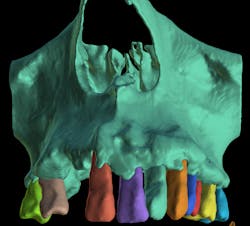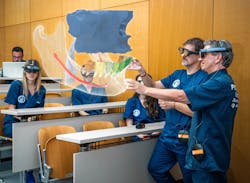Artificial intelligence and augmented reality: Practical applications in dentistry
Artificial intelligence (AI) is not new. It has been around since the 1950s. Its current use in dentistry has largely been driven by increased computational ability and the availability of large volumes of data from human experience. Current AI technologies harvest these two key changes with the help of algorithms that are written to mimic human cognitive abilities.
For a few years now, CAD software for dental restorations has employed AI to generate restorative morphology based on human tooth libraries. Other examples of AI can be found in implant treatment planning software features such as automatic nerve generation.
Current AI techniques combine data and information from various sources to arrive at results that can exceed human capability. What this means is that computational power can be harvested to glean data from various streams to constantly assess any known or unknown correlations and generate information the human mind is incapable of processing in such large volumes. When the volume of data is significantly large, the algorithms that underlie a specific AI technology can be better and more consistent.
You may also be interested in ... The impact of clinical automation on dental practice valuation
Machine learning
AI is based on what is called “machine learning.” This form of learning, used to describe an algorithm’s ability to “learn” from large datasets, is fundamentally classified as either supervised learning, unsupervised learning, or semisupervised learning.
Supervised learning uses data generated from large volumes of human work, such as diagnostic data from thousands of orthopantomograms assessed by maxillofacial radiologists. This kind of learning can involve descriptive datasets that are used as models for a machine to learn from.
Unsupervised learning, on the other hand, is completely independent of human input and can be based purely on large volumes of undescribed data, as is the case with human tooth morphology being used to generate restorative form in CAD.
Semisupervised learning uses a combination of supervised and unsupervised learning.
Deep learning is an even more important type of learning commonly recognized as a subset of machine learning. Deep learning can combine the multiple forms of learning to help generate artificial neural networks that can also become interconnected for augmented abilities. The most well-known types of neural networks are artificial neural networks (ANNs), convolutional neural networks (CNNs), and generative adversarial networks (GANs). Each neural network is fundamentally comprised of nodal layers that are completely artificial. In essence, neural networks consist of artificial neurons that are mathematical model systems influenced by the human neuron. Layers of these artificial neurons are assembled and interconnected by several mathematical operations to generate a network capable of specific task solutions. Deep learning neural networks can generate features from large datasets and use a complex multilayer system with a greater number of interconnected neurons.
You may also be interested in ... AI in dentistry: Leading the revolution
AI in restorative dentistry
There is probably no more widely used application of AI than restorative design in CAD software. Based largely on human (or now even digital) tooth libraries, restorative designs in software like CEREC, 3Shape, Exocad, and others, are extremely accurate. These designs often require little or no human intervention for correction, and they consistently generate accurate form, interproximal contacts, occlusal contacts, and soft-tissue emergence profiles.
Algorithms are now being written for generation of custom designs that are not necessarily based on a library. Restorative AI technology is beginning to drive design in other aspects of prosthodontics as well as in the case of complete dentures, splints, implant restorations, implant superstructures, and substructures.
AI in maxillofacial radiology
Possibly the fastest-growing segment of AI use in dentistry is in maxillofacial radiology. AI is driving detection, diagnosis, and disease prediction in a manner that few other dental specialties are. The basis for this increased use of AI rests on large datasets of intraoral and extraoral radiographs and cone-beam computed tomography (CBCT). AI can assess both 2D and 3D radiography more consistently than humans.
AI is currently being used to diagnose maxillofacial pathology in its earliest form, bringing expertise even in the hands of a “nonexpert.” AI software is used extensively for second opinions, which helps improve the quality of detection and diagnosis. 2D radiographs are routinely obtained in dental exams around the globe every day, and the quality of their evaluation can be affected by human factors such as exhaustion, stress, and intellectual ability. AI can level the playing field and bring consistency to radiographic evaluation.
There is significant commercial interest in these technologies from dental insurance companies and other entities that value early detection and diagnosis. The cost and degree of intervention can escalate when detection of pathology is missed, and an effective diagnosis is not made early on.
AI in dental implantology
Recent years have seen escalated development in the use of AI in dental implant treatment planning. AI is routinely used in treatment-planning software to align surface and radiological datasets, such as intraoral scans and CBCT, respectively. More recently, AI has been used to generate the path of the inferior alveolar and other nerves within radiological anatomy.
You may also be interested in ... The continued evolution of dental implant surgical guides with material innovations
Of significant interest is the use of AI to generate tooth and bone segmentation models (figure 1). Tooth segmentation enables software-simulated digital extraction of a tooth or teeth that are planned for extraction. This in turn helps clinicians generate simulated tooth models for the creation of predictive tooth-supported surgical guides. Bone segmentation allows clinicians to plan advanced procedures such as bone resection. This lets clinicians simulate predictive models that support bone-based guides for bone resection, implant placement, and temporization as a series of interconnected parts. Some software also uses AI to plan implant positions in simple clinical situations such as single dental implants intended to replace a single missing tooth in an arch.
AI in oral and maxillofacial surgery
The use of AI in bone segmentation also enables maxillofacial surgeons to generate predictive bone models for use in orthognathic surgery, maxillofacial trauma, and surgery for the treatment of maxillofacial deformities. These surgical procedures can benefit significantly from high-precision planning by giving maxillofacial surgeons clear software replication of the surgical sites. Some procedures, such as skeletal expansion, can also benefit from simulated outcomes that aid planning as well as patient education.
AI is also being developed to enhance the prediction of soft-tissue results following maxillofacial surgery. AI-driven bone segmentation is employed to 3D print maxillofacial models used to fabricate patient-specific implants, joint replacements, and partial/full skeletal replacements following maxillofacial cancer resections.
AI in orthodontics
The use of AI in orthodontics has largely been driven by AI-based tooth segmentation and the positional calculation of teeth based on known orthodontic planning ratios (figure 2). Large datasets are used to “learn” algorithms that can account for morphological variations of teeth and various types of skeletal arch form. Sequenced algorithms can then be developed for simulated, staged tooth movement in a way that accounts for occlusal interferences or interproximal obstruction.
This can translate to the production of staged orthodontic treatment simulation models that can be used to produce orthodontic aligners. Software-generated trim lines are increasingly being used for aligner trimming/cutting for large-scale orthodontic aligner production. AI is in development for direct printed aligners, which can eliminate models that are used in conventional thermoforming techniques. This will facilitate the use of 3D printing to produce aligners. Orthodontic monitoring of treatment progress is an area beginning to incorporate AI.
AI in dental research
AI in dental research has been in the limelight for quite some time because of what are known as large language models (LLMs), such as ChatGPT. Essentially, LLMs are trained on very large amounts of textual data and consequently can perform various language-related tasks. There are significant fears that LLMs come with risks of misinformation, malicious use, and other technological limitations. Notwithstanding these concerns, LLMs have tremendous potential to be a significant tool in dental research. Some publishers, however, have banned the use of AI-generated text in any form and require voluntary reporting of the use of LLM tools.
AI and AR
Augmented reality (AR) is a rapidly developing disruptive technology that is set to redefine the use of digital technologies in dentistry. Reality manipulation originally began with what is well known as virtual reality (VR), a technology that allows interaction with virtual objects in real time. VR consists of two important components: immersion and interaction. The level of immersion in VR significantly isolates the operator from the surrounding environment. This can be disruptive and disorienting. This isolation also prevents the operator from taking in any elements of the physical environment.
Augmented or mixed reality techniques, on the other hand, superimpose computer-generated virtual content on the existing physical environment. This typically enhances the operator’s perception of reality. AR employs high-definition holograms that the operator can interact with while remaining connected to the physical environment. In a mixed reality environment, for example, an operator could be physically treating a patient and simultaneously viewing a hologram.
While currently used mainly for patient presentation and treatment planning, AR has tremendous potential to positively affect multiple dental specialties (figure 3). Proof of concept has already been demonstrated for assisted implant planning and guided surgery. AR relies on AI-driven alignment of various datasets such as facial scans, intraoral scans, CBCT, and software-generated 3D meshes. Automated 3D segmentation underlies much of AI-driven alignment and is also a basic technology that makes AR possible.
The potential of AI
AI has tremendous potential to positively disrupt the current practice of dentistry. A significant percentage of the profession views AI with a degree of caution, and some fear that AI could replace the human operator. However, accurately understanding the technologies that underlie AI indicates that it has great potential for adjunctive use in dentistry.
You may also be interested in ... ChatGPT: Will it revolutionize the dental industry?
Editor's note: This article appeared in the October 2023 print edition of Dental Economics magazine. Dentists in North America are eligible for a complimentary print subscription. Sign up here.
About the Author

Nitish Surathu, MDS, BDS
Nitish Surathu, MDS, BDS, practices in New Zealand. He is an associate fellow of the American Academy of Implant Dentistry, and a fellow and diplomate of the International Congress of Oral Implantologists. He has lectured internationally on periodontics, dental implants, and digital dentistry. Dr. Surathu is a director with the ACE Institute and digitaldentition.com, and is involved in evaluating new-generation digital technologies.
Updated June 7, 2023

Neeraj Surathu, BDS
Neeraj Surathu, BDS, is a current postgraduate prosthodontic resident at Nova Southeastern University in Florida. After completing his BDS, he went on to work as a dental lab technician in New Zealand, where much of his work revolved around digital workflows. His interest in digital dentistry saw him commence a formal postgraduate prosthodontics program in 2021. Dr. Surathu has a keen interest in all things dental and digital besides surgical prosthodontics and artificial intelligence.



